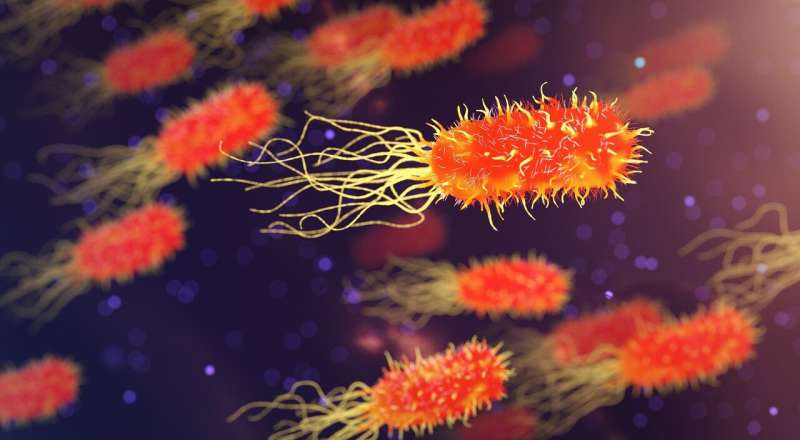Credit: Pixabay/CC0 Public Domain
A bout with flesh-eating bacteria can start out with a day at the beach, a hardly worrisome cut and then, in less than 24 hours, a raging infection fought with heavy antibiotics and gruesome scalpel work.
It would be reassuring to know where and when Florida's coastal waters are ripe with "one of the fastest growing organisms on earth," said a University of Central Florida scientist.
Salvador Almagro-Moreno, a native of southern Spain, graduate student in Ireland and researcher at Dartmouth College, arrived at UCF in 2017, where he is now an assistant professor of medicine. He's diving into the mysterious world of flesh-eating bacteria, which is nasty stuff for sure, but there's a bigger target on his to-do list.
His main school of thought, from where he orchestrates research, instructs students and hopes to bring a difference, is from a concept called One Health, which the COVID-19 pandemic has ushered into prime time.
One Health acknowledges intricate, if often poorly known ties between people, animals, plants and their ecosystems in an interwoven fabric of life.
One Health expects that assaults from climate change, population growth and environmental destruction could fray that fabric or shred it disastrously, resulting in diseases such as cholera outbreaks, Ebola epidemics and, as suspected, the novel coronavirus, or COVID-19 pandemic and its 6 million global deaths, and still others nobody has heard of yet.
Almagro-Moreno wrote the cover story, "The Rise of New Pathogens," for the current May-June edition of the American Scientist magazine.
"The emergence of novel human pathogens is without a doubt one of the most pressing problems that we face," he said in the story. "I have been working for almost two decades trying to understand what the biological rules and evolutionary forces are that make a microorganism transition to causing disease in humans."
Almagro-Moreno is pursuing simple but daunting questions: what are the warning signs for looming disease calamities, and how can they be interpreted and best communicated?
Each day, for example, the U.S. Environmental Protection Agency issues predictions at airnow.gov for several days of air quality.
The ozone smog forecast for Orlando was for moderate concern on Wednesday, meaning that people who are "unusually sensitive" to the lung-damaging pollutant should consider shortening activities outdoors.
Otherwise, forecasts for Thursday through Sunday called for good, or low levels of ozone smog.
That's something of the approach that Almagro-Moreno hopes to achieve.
But trying to predict the behavior of a potentially lethal organism as it ricochets among environmental fluctuations, interactions with animals and potential infections of humans—that's way harder than forecasting the health risk of ozone smog, he said.
In no small part it's harder because One Health science is in its infancy. In a sense, Almagro-Moreno is just beginning to develop momentum at laboratory.
"We know very little about the rules of pathogen emergence," Almagro-Moreno said.
Florida struggles now with a pair of troublemakers that—incubated in natural environments, exacerbated by pollution and affecting people—speak to the One Health concept.
One is the occurrence along the state's southwest coast of red tides, which are composed of single-cell organisms producing neurotoxins. They have caused massive die-offs of marine life and driven away tourists with lung-irrigating fumes.
Another is blue-green algae, or cyanobacteria producing toxins in fresh waters, including many Orlando lakes, and including Lake Ivanhoe, which is popular for aquatic sports but now is posted as hazardous because of cyanobacteria.
Almagro-Moreno lives nearby in the Mills 50 district and met at Lake Ivanhoe to discuss his research.
To understand the effects of chemicals or environmental exposures, or to unravel genetic traits, scientists often turn to four creatures, the fruit fly, zebra fish, roundworm and mouse, for experiments.
Those four, all well documented, are called model organisms.
For his One Health investigations, and more specifically to probe the behaviors of waterborne pathogens, Almagro-Moreno also chose model organisms, but of a different nature.
The first is cholera, a disease recorded in thousands of years of history. He and students are collaborating with Asian and Latin American countries to probe the evolution and outbreaks of cholera.
The second is a native of Florida, one that can be contracted through the prick of fish spine, nick from a seashell or, as well, from eating raw oysters.
It is flesh-eating bacteria. "This is their home—they have been here far longer than we have," Almagro-Moreno said. The microorganism, he said in a TEDx talk a few years ago, "a very proud Florida native."
To understand its behaviors, whether in a chill mode or on a rampage, his students have gone to the Indian River Lagoon in Brevard County for sampling of bacteria, environmental conditions and other factors.
"I thought it was really suitable," he said of flesh-eating bacteria, "for understanding what do you need to become a pathogen, what do you need to colonize humans, what do you need to kill humans and how does the environment affect those traits?"
His ultimate goal is to develop a standardized approach for assessing and predicting emerging pathogens, an approach that can then have applicability for assessing other threatening organisms.
"But, to be honest … the beauty of it is that I live in Florida," he said. "So this work matters to me as a Floridan. It's a win-win."
Terrible outbreaks of disease are not new, Almagro-Moreno said.
"Unfortunately for those of us trying to forecast them, they do not typically occur in a slow and predictable fashion," Almagro-Moreno wrote in his American Scientist story.
"Harmless organisms can undergo quantum leaps in evolution to become deadly and then spread like wildfire."
©2022 Orlando Sentinel.
Distributed by Tribune Content Agency, LLC.
























